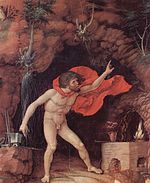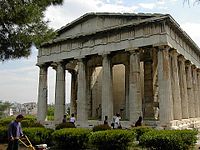Hephaestus
From Wikipedia, the free encyclopedia
| Hephaestus | |
 Hephaestus in his forge, by Andrea Mantegna (1431-1506). |
|
| God of Technology, Blacksmiths, Craftsmen, Artisans and Volcanoes | |
| Symbol | Hammer, Anvil or Tongs |
|---|---|
| Consort | Aphrodite or Charis |
| Parents | Hera |
| Children | Erichthonius of Athens |
| Roman equivalent | Vulcan |
Hephaestus (pronounced /hɨˈfiːstəs/ or /hɨˈfɛstəs/; Greek Ἥφαιστος Hēphaistos) was a Greek god whose Roman equivalent was Vulcan. He was the god of technology, blacksmiths, craftsmen, artisans, sculptors, metals, metallurgy, fire and volcanoes. Like other mythic smiths but unlike most other gods, Hephaestus was lame, which gave him a grotesque appearance in Greek eyes. He served as the blacksmith of the gods, and he was worshipped in the manufacturing and industrial centers of Greece, particularly in Athens. The center of his cult was in Lemnos [1]
Hephaestus's symbols are a smith's hammer, an anvil and a pair of tongs, although sometimes he is portrayed holding an axe. His counterpart in Hindu myth is Agni (The God of Fire)
Contents |
[edit] Origin
Hephaestus was identified by Greek colonists in southern Italy with the volcano gods Adranus of Mount Etna and Vulcanus of the Lipari islands. His forge was moved there by the poets. The first-century sage Apollonius of Tyana is said to have observed, "there are many other mountains all over the earth that are on fire, and yet we should never be done with it if we assigned to them giants and gods like Hephaestus".[2]

An Athenian founding myth tells that Athena refused a union with Hephaestus because of his unsightly appearance, and that when he became angry and forceful with her, she disappeared from the bed. His ejaculation landed on the earth, impregnating Gaia, who subsequently gave birth to Erichthonius of Athens; then the surrogate mother gave the child to Athena to foster, guarded by a serpent. Hyginus made an etymology of strife (Eri-) between Athena and Hephaestus and the Earth-child (chthonios). There is a Temple of Hephaestus, the Hephaesteum miscalled the "Theseum", located near the Athenian agora, or marketplace.
On the island of Lemnos, his consort was the sea nymph Cabeiro, by whom he was the father of two metalworking gods named the Cabeiri. In Sicily, his consort was the nymph Aetna, and his sons two gods of Sicilian geysers called Palici.
Homer makes Charis the wife of Hephaestus. However, according to most myths, Hephaestus is a husband of Aphrodite, who commits adultery with Ares.
[edit] Craft
Hephaestus crafted much of the other magnificent equipment of the gods, and almost any finely-wrought metalwork imbued with powers that appears in Greek myth is said to have been forged by Hephaestus: Hermes' winged helmet and sandals, the Aegis breastplate, Aphrodite's famed girdle, Agamemnon's staff of office,[3] Achilles' armor, Heracles' bronze clappers, Helios' chariot as well as his own due to his lameness, the shoulder of Pelops, Eros' bow and arrows. Hephaestus worked with the help of the chthonic Cyclopes, his assistants in the forge. He also built automatons of metal to work for him. He gave to blinded Orion his apprentice Cedalion as a guide. In one version of the myth, Prometheus stole the fire that he gave to man from Hephaestus's forge. Hephaestus also created the gift that the gods gave to man, the woman Pandora and her pithos.
In Iliad i.590, Zeus threw Hephaestus from Olympus because he released his mother Hera who was suspended by a golden chain between earth and sky, after an argument she had with Zeus. Hephaestus fell for nine days and nights before landing on the island of Lemnos where he grew to be a master craftsman and was allowed back into Olympus when his ability and usefulness became known to the gods.
| Greek Deities Series | ||||||||||||
|---|---|---|---|---|---|---|---|---|---|---|---|---|
| Primordial deities | ||||||||||||
| Titans (predecessor deities) | ||||||||||||
| Greek sea gods | ||||||||||||
| Chthonic deities | ||||||||||||
| Muses (personified concepts) | ||||||||||||
| Other deities | ||||||||||||
| The Twelve Olympians | ||||||||||||
|
[edit] The lame smith
Hephaestus is the only Olympian god to have been exiled from Olympus and to have returned. In a Homeric version of Hephaestus's myth, Hera, mortified to have brought forth such grotesque offspring, promptly threw him from Mount Olympus. He fell nine days and nights and landed in the ocean,[4] where he was brought up by the Oceanids Thetis (mother of Achilles) and Eurynome.
Hephaestus gained revenge against Hera for rejecting him by making her a magical golden throne, which, when she sat on it, did not allow her to leave it. The other gods begged Hephaestus to return to Olympus to let her go, but he repeatedly refused. At last Dionysus shared his wine, intoxicating the smith, and took him back to Olympus on the back of a mule, a scene that often appears on painted pottery of Attica.
Hephaestus was reported in myth as cholōs, "lame",[5] crippled, halting (ēpedanos) and misshapen, either from birth or as a result of his fall: in the vase-paintings, Hephaestus is shown lame and bent over his anvil, his feet sometimes back-to-front: Hephaistos amphigyēeis. He walked with the aid of a stick. The Argonaut Palaimonius, "son of Hephaestus"— which is to say a bronze-smith— was also lame.[6] Other "sons of Hephaestus" were the Kabeiroi on the island of Samothrace; they were identified with the crab (karkinos) by the lexicographer Hesychius, and the adjective karkinopous, "crab-footed" signified "lame", Detienne and Vernant[7] have observed: the Kabeiroi were seen as lame too.[8] In some myths, Hephaestus built himself a "wheeled chair" or charioteer with which to move around, thus helping him overcome his lameness while showing the other gods his skill.[9] In the Illiad it is said that Hephaestus build some bronze human machines to help him get around.
Hephaestus’s physical appearance indicates arsenicosis, low levels of arsenic poisoning, resulting in lameness and skin cancers. In place of less available tin, arsenic was added to copper in the Bronze Age to harden it; most smiths of the Bronze Age would have suffered from chronic workplace poisoning, and the mythic image of the lame smith is widespread.[10]
[edit] Hephaestus and Aphrodite
Hephaestus released Hera after being given Aphrodite, the goddess of love, as his wife. In another version of the myth, Hephaestus, being the most unfaltering of the gods, was given Aphrodite’s hand in marriage by Zeus in order to prevent conflict over her between the other gods.
In either case, Hephaestus and Aphrodite had an arranged marriage and Aphrodite, disliking the idea of being married to unsightly Hephaestus, began an affair with Ares, the god of war. Eventually, Hephaestus found out about Aphrodite’s promiscuity from Helios, the all-seeing Sun, and planned a trap for them during one of their trysts. While Aphrodite and Ares lay together in bed, Hephaestus ensnared them in an unbreakable chain-link net so small as to be invisible and dragged them to Mount Olympus to shame them in front of the other gods for retribution. However, the gods laughed at the sight of these naked lovers and Poseidon persuaded Hephaestus to free them in return for a guarantee that Ares would pay the adulterer's fine. Hephaestus states in the Odyssey that he would return Aphrodite to her father and demand back his bride price: this is the one episode that links them.
In Homer's Iliad the consort of Hephaestus is a lesser Aphrodite, Charis "the grace" or Aglaia "the glorious", the youngest of the Graces, as Hesiod calls her.[11] Hephaestus fathered several children with mortals and immortals alike. One of those children was the robber Periphetes. With Thalia, Hephaestus was sometimes considered the father of the Palici.
The Thebans told that the union of Ares and Aphrodite produced Harmonia, as lovely as a second Aphrodite.[citation needed] But of her union with Hephaestus, there was no issue, unless Virgil was serious when he said that Eros was their child.[12] Later authors might explain this statement when they say the love-god was sired by Ares but passed off to Hephaestus as his own son.
Hephaestus was somehow connected with the archaic, pre-Greek Phrygian and Thracian mystery cult of the Kabeiroi, who were also called the Hephaistoi, "the Hephaestus-men," in Lemnos. One of the three Lemnian tribes also called themselves Hephaestion and claimed direct descent from the god. He had a follower who named himself Hephacules after him.[citation needed]
He had comparatively few epithets. One was Hephaestus Aetnaeus, owing to his workshop supposedly being located below Mount Aetna.[13]
The minor planet 2212 Hephaistos discovered in 1978 by Soviet astronomer Lyudmila Chernykh is named in his honor.[14]
[edit] Notes
- ^ Walter Burkert, Greek Religion 1985: III.2.ii; see coverage of Lemnos based traditions and legends at Mythic Lemnos)
- ^ Life of Apollonius of Tyana, book v.16.
- ^ its provenance recounted in Iliad II
- ^ as he tells it himself in the Iliad (xviii.395)
- ^ Odyssey viii.308; Iliad xviii.397, etc.
- ^ Apollonius of Rhodes, Argonautica i.204.
- ^ Marcel Detienne and Jean-Pierre Vernant, Cunning Intelligence in Greek Culture and Society, trans. Janet Lloyd (Atlantic Highlands NJ: Humanities Press), 1978:269-72, cited by Morris Silver, Taking Ancient Mythology Economically 1992:35 note 5.
- ^ Hephaestus' Roman counterpart Vulcan was seen as lame also. In Ugarit, among other parallels with Greek myth, the craftsman-god Kothar Hasis limps about (Baruch Margalit, Aqhat Epic 1989:289); in Egypt, Herodotus (iii.36) was given to understand, the craftsman-god Ptah was club-footed. Compare the Nordic lame bronzeworker Weyland the Smith.
- ^ Jay Dolmage, "'Breathe Upon Us an Even Flame': Hephaestus, History, and the Body of Rhetoric," Rhetoric Review Vol. 25, No. 2 (2006), 119-140. 120.
- ^ H. W. F. Saggs, Civilization Before Greece and Rome, (New Haven: Yale University Press, 1989:p200-2001.
- ^ in his Theogony 945
- ^ Aeneid i.664
- ^ Aelian, Hist. An. xi. 3
- ^ Schmadel, Lutz D. (2003). Dictionary of Minor Planet Names (5th ed.). New York: Springer Verlag. pp. 180. ISBN 3540002383. http://books.google.com/books?q=2212+Hephaistos+SB+1978+5849.
[edit] External links
| Wikimedia Commons has media related to: Hephaestus |
- Theoi Project, Hephaestus in classical literature and art
- Greek Mythology Link, Hephaestus summary of the myths of Hephaestus


